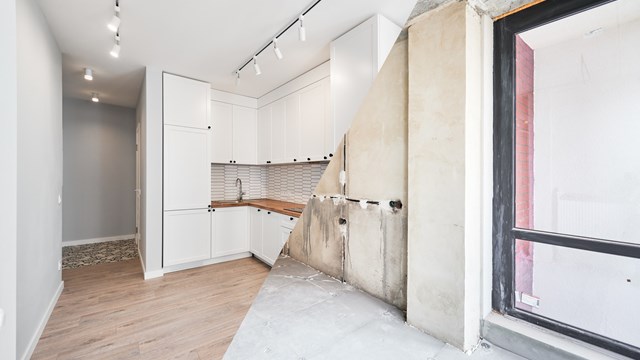The far west side of Manhattan has been a flurry of activity and speculation in the last couple of years thanks to the debate over the development of the Hudson Rail Yards and a new stadium for the New York Jets.
In a scenario that has played out whenever a major new development proposal is made, developers and city government officials are squaring off against each other and against residents, environmentalists, and public advocates, all clamoring to make their voices heard over how best to use the area in debate.
That area encompasses roughly 50 blocks that have historically been dominated by warehouses, taxi garages, the Hudson Rail Road yards, the Jacob Javits Convention Center, and entrances to the Lincoln Tunnel. The area also happens to be, according to the New York City Department of City Planning, "[The] one last frontier available in Manhattan - the underutilized area bounded roughly by West 42nd Street and West 30th Street, Eighth Avenue to the Hudson River."
While the vast majority of Midtown Manhattan has been built out to near capacity, the West 30s and 40s have lain largely fallow for nearly a century. As more people have moved into the area in search of slightly cheaper rents and space becomes more and more of a premium in more developed neighborhoods however, developers have turned their attention to the area and considered its potential.
The biggest idea proposed for the neighborhood is a multi-million-dollar stadium to house the New York Jets - as well as serve as a potential home for the 2012 Olympic games, should New York City be chosen to host the event. While the stadium is to be the centerpiece of the development, the Department of City Planning says, "The vision for Hudson Yards is to transform today's underused Far West Side into a place where New Yorkers and tourists will want to live, work, play and visit."
To achieve that vision, along with the stadium would come office and commercial property development, new residential high-rises, an extension of the 7 train to better serve the area, an expansion of the Javits Center, and an adjacent network of public parks and green spaces along the Hudson River.
According to the plans laid out by City Hall and the Department of City Planning, the New York Sports and Convention Center would sit on a platform over the rail yards from 30th to 33rd Streets between 11th and 12th Avenues. The facility would be the 75,000-seat home of the Jets football team, a massive convention facility providing up to 210,000 square feet of exposition space and meeting rooms to complement the Jacob K. Javits Convention Center, and possibly serve as Olympics HQ in 2012 with seating for 45,000. With all those possibilities and that much sheer space, the hope is that the complex will generate vast revenues that will not only pay for the complex itself, but stimulate the entire area and spark residential, commercial, and entertainment development.
Such a massive project entails massive capital investment, however. Including the $375 million estimated cost of the rail yard platform and the $225 million needed to put a retractable roof over the stadium to make it useable for trade shows and concerts in colder months, the total cost of the facility is estimated at $1.4 billion, part of which will be paid for by the Jets, part by the state, and the remainder by the city. For its part, the Bloomberg Administration has argued that the facility will generate enough new tax revenues to allow the city and the state to easily recoup their investments and pay for itself many times over once it's up and running.
In the meantime though, there are some big issues to be untangled, not least of which is determining the value of the 13 acres of the land lying under the Hudson Yards - which is owned by the MTA and has been valued at anywhere from $100 million to just slightly less than $1 billion, depending on who's making the offer, or who stands to be undercut by an unfavorable figure in either direction.
From the moment the plans were announced, the various government and private groups involved with the stadium project - both pro and con - have been furiously spinning their points of view on how the development will (or won't) impact the immediate neighborhood, the environment, and Manhattan as a whole.
Proponents of the project, like the mayor's office and the Jets franchise itself, claim that the stadium complex alone will generate nearly 7,000 new jobs for the city, as well as multi-millions of dollars a year in pure profits.
According to the Jets' website, "The Independent Budget Office, an extremely conservative and critical watchdog agency, has also found that the project will generate far more revenue than it costs to build. This means that on a year-by-year basis, New York will have more money than it would have if it didn't invest in the project."
The situation, however, is perhaps slightly more complex. In the ongoing point-counterpoint debate, the Independent Budget Office (IBO) recently updated its previous estimates about the financial impact of the stadium/convention center proposal, further downgrading their earlier projections in July of 2004. In its newsletter, it says, "IBO has analyzed the economic and fiscal impacts of the proposed New York Sports and Convention Center on Manhattan's far West Side, finding it would generate fewer jobs and less revenue for the city than claimed by the project's proponents."
Under February 2005 estimates, IBO believes the facility would create 3,465 jobs - barely half the 6,971 claimed by the project's proponents - and generate $25.5 million in new city tax revenue annually, more than $9.6 million less than what the project's supporters expect.
While this lower tax revenue would still be sufficient to cover the roughly $21 million in annual debt service for the city's multi-million investment in the project, the margin would be somewhat narrower than projected by the Bloomberg Administration.
While the IBO does agree that the project will eventually translate into revenues for the city, the plan has met with a great deal of resistance from many who question the actual benefits of the project will be, both in the short and long term. There are those who look askance at the way in which the plans were hatched and presented to the public, others who question how it's to be paid for, and whether that money should be put to better use elsewhere, those who are concerned about the environmental impact of such a huge project, and still others who simply don't want an enormous, traffic-generating sports arena in what amounts to their backyard.
In a speech he delivered at the New School in Manhattan this past January, prospective 2005 mayoral candidate Anthony Weiner said that the city's plan for financing the stadium and surrounding developments reads like a complicated word problem.
"I have a chart here that details how the money [for the stadium project] is funneled to avoid public scrutiny and votes," said Weiner. "You'll see the Rube Goldberg design"¦The city and the state create a new, unaccountable public authority - the Local Development Corporation, or LDC. It issues $600 million in bonds to pay for the platform under and the roof over the stadium, which the city and the state supposedly agree to repay. Then the Triborough Bridge and Tunnel Authority conveys the rights to the rail yards to the Metropolitan Transportation Authority. The MTA leases the airspace above the rail yards to the LDC. The LDC leases airspace to Albany's Empire State Development Corporation, [which in turn] leases the airspace to the city. The city leases the airspace back to the ESDC, which turns around and leases the airspace to the LDC. The LDC leases the airspace to Jets Development, and then issues another $400 million in Jets bonds for the Jets - ultimately backed up by the taxpayer - to help build the stadium itself. Finally, the ESDC leases the platform that's built to the MTA for $1. If you understand it," says Weiner, "you weren't supposed to."
Stadium supporters, on the other hand, see things very differently. Tom McMorrow, a sports columnist and co-founder of the group called WestSideStadium.org, framed the development in remarks he delivered at the Javits Center during one of the many public forums held to discuss the issue:
"Now we have a proposal on the table"¦to invest in the future of the city, to build a stadium as the starting point for growth for this area. The financing is simple," says McMorrow. "The New York Jets and the NFL put up $800 million, plus a guarantee against any cost overruns. The state puts up $300 million. That's $1.1 billion of private and state money. The city then puts up $300 million. And what does the city get for its $300 million? It gets a unique facility, a building that dwarfs the earning potential of any other stadium ever built. A money-maker."
Aside from vastly differing opinions on the stadium's financing specifics, debate also rages over the use of so much money for a sports and entertainment complex when New York City school districts are struggling against budget cuts and other city departments like Fire and Sanitation are being forced to close stations and scale back services to save money.
One group strongly opposed to the stadium project on just those grounds is the New York Association for Better Choices (NYABC), a coalition of community leaders and neighborhood groups that includes New York City Public Advocate Betsy Gotbaum; New York State Senator Thomas Duane, New York State Assembly Member Richard N. Gottfried; City Council Deputy Majority Leader Bill Perkins and Council Member Christine Quinn; Anna Levin, a member of the Hell's Kitchen/Hudson Yards Alliance; and, former Deputy Fire Chief Vincent Dunn.
According to the group's mission statement, "[Our organization] is alarmed by commitments to dedicate at least $600 million in public funds to the stadium project at a time when schools are failing, firehouses are closing and other critical city functions are under-funded. NYABC supports the effort to bring the 2012 Olympics to New York City and to appropriately revitalize the Javits Center through expansion, but feels that both important initiatives are being jeopardized by artificial and opportunistic ties to the proposed West Side Jets football stadium."
According to U.S. Rep. Jerrold Nadler, D-8, "This stadium will not only waste taxpayer money, but it will do little to further economic development on the West Side"¦Taxpayers' money would be better spent on improving our city's schools, caring for our seniors, and building affordable housing."
Even those staunchly against the West Side stadium plans agree that if New York City is to host the 2012 Olympic Games, new state-of-the-art facilities will be needed. One option put forth for both the Olympic complex and the Jets stadium is Queens.
"We offer Queens as the best idea," says David Oats, chairman of the Queens Olympic Committee and a member of NYABC. "A stadium opportunity [there] will save New York City billions of dollars on a site that has served two World's Fairs and annually hosts the U.S. Open, New York's most prestigious international sporting event. We can save the New York Olympic dream and bring the New York Jets back to their first and true home, Flushing Meadows."
Queens would also be an undeniably less expensive option, according to Weiner. In his address at the New School, Weiner noted that "An internal memo by [Deputy Mayor] Dan Doctoroff's own organization, NYC 2012, said: "˜Construction costs [in Willets Point, Queens] would be substantially lower than on the West Side.' The cost of doing both the Javits Center and the West Side Stadium would be $2.8 billion dollars. The cost of doing a stadium at Willets Point and the Javits Center - assuming the facility in Queens costs roughly the average of the last five NFL stadiums - would be $1.8 billion. That represents a cost savings of almost $1 billion, or 34 percent."
Regardless of how Manhattan's Far West Side is handled in the next few years, one thing is certain: any move by the city, the state, or private developers will be met with heated debate over the methods and motives behind it. Just last month, the owners of Madison Square Garden offered the MTA $600 million for the land under the Hudson Yards in a bid to shut down what they feel is a threat to their own sports and entertainment business. What it comes down to - and what it nearly always comes down to in any development debate here in the city - is which side holds more influence, whose pockets are deepest, and what deals get cut in the eleventh hour.
For the city's plans and perspective on the development of the Far West Side, visit the Department of City Planning's page on the issue at
To learn more about the New York Association for Better Choices, visit their website at
For more information and FAQ's regarding the New York Convention Center and the Jets' involvement, visit
To read the Independent Budget Office's full report on the fiscal implications of the project, visit






Leave a Comment